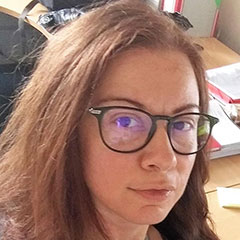Computational Systems Biology for Complex Human Disease: From static to dynamic representations of disease mechanisms (Virtual)
7–11 December 2020
Virtual course
Interactive training for functional analysis and interpretation of disease data using computational modelling tools
Summary
Due to the ongoing situation with Covid-19, this course will be delivered in a virtual format.
This exciting new course will focus on applied, functional analysis and interpretation of disease data using computational modelling tools.
The week-long programme will cover both static (networks) and executable (models) representations of disease mechanisms with a focus on discrete computational modelling concerning complex human diseases such as Cancer (and pre-cancer), Rheumatoid Arthritis, Parkinson’s’ and others.
The behaviour of cells is fundamentally controlled by networks of interacting biomolecules. Almost all biological processes can be viewed in the form of interaction networks where biological components are represented as “nodes” and the interactions between two components are represented as “edges”. Such representations that link biomolecules to their functional environment can provide substantial insights into the mechanisms of control by further analysing their underlying structure.
Networks can also serve as templates for visualising and analysing “omics” datasets, but rest however relatively limited by their static nature in capturing the dynamics of multiple biological processes. This includes both how multiple partners interact and work together to activate pathways, but also how the order of events within a network may change the functional outcome. The fine-grained relationships between proteins and genes in the cell become particularly important in disease states where the healthy interactions and activities have been subverted.
Computational modelling provides the means to study the emerging behaviour of the system under different conditions, by performing in silico simulations and perturbations. Thus, a passage from static to dynamic, executable networks is essential for in depth system analysis.
Target audience
This course is aimed at PhD students, postdocs and clinicians/healthcare professionals who are interested in using systems biology approaches and discrete computational modelling to tackle biological and biomedical problems concerning human disease.
The course is intended to be accessible and beneficial to applicants without advanced bioinformatics skills or experience. However, to fully benefit from the course participants should:
- be familiar with bioinformatics tools, platforms and data resources
- be familiar working in a Linux environment and have a basic knowledge of a programming language (Python, R etc.)
Numerous free online resources are available for these, including:
http://www.ee.surrey.ac.uk/Teaching/Unix/
https://www.guru99.com/unix-linux-tutorial.html
https://www.datacamp.com/courses/free-introduction-to-r
https://www.datacamp.com/courses/intro-to-python-for-data-science
Programme
For our virtual courses, we use video conferencing (Zoom) and instant messaging (Slack) applications along with other online and virtual machine (VM) teaching resources to deliver the different elements of the course as interactively as possible.
The course will run approximately 10:00-17:00 (GMT) daily. Some teaching materials may be pre-recorded but participants must be available to attend live, interactive sessions online between these times.
The virtual programme will consist of lectures, discussions, and computational exercises covering the following topics:
Static Disease Networks (molecular maps, pathway assembly, structural analysis etc.)
- Overview of databases/ resources
- Different network representations (Process Description, Activity Flow)
- Overview of different standards, languages (SBGN, SBML, etc.)
- Topological and functional analysis
- Interactive network visualization
- Tools: CellDesigner, Cytoscape, MINERVA and plugins
Dynamic Disease Networks (Stochastic Models, Logical (Boolean)/ Discrete Models)
- Network/ Model Curation and sharing
- Disease Network translation
- Logical/Discrete modelling and simulation of disease networks, and analysis of their dynamical properties
- Stochastic modelling and simulations
- Tools/frameworks: CaSQ, GINsim, CellCollective, BioLQM, CoLoMoTo notebook, BioModelAnalyzer, Z3, MaBoSS
Workflow
The course will start from static representations of disease mechanisms in forms of networks, covering aspects of network representation and resources, topological analysis and interactive network visualization.
Gradually, with the addition of logical descriptions (automatically or manually) of the regulations depicted in the networks we will pass from static graphs to dynamic networks.
We will explore a number of computational modelling tools that allow for in silico simulations and perturbations in order to understand emerging behaviours of the system under different biological scenarios and move to more in depth dynamical analysis (finding stable states, attractors, performing in silico knockouts, sensitivity analysis etc.).
The complexity of the tools will also gradually rise (from GUI to program based) following the complexity of the biological questions.
Scripts, cheat sheets and other teaching materials will be provided along with instructor support to ensure that all participants are able to follow and progress throughout the week.
Scripts, cheat sheets and other teaching materials will be provided along with instructor support to ensure that all participants are able to follow and progress throughout the week.
Learning Outcomes
After completing the course, participants should be able to:
- Understand differences between static and dynamic representations of disease mechanisms
- Retrieve disease networks/ mechanisms from dedicated public repositories and databases
- Use a range of computational modelling software to develop discrete computational models
- Choose appropriate modelling approach depending on the disease mechanism and available data
Instructors and speakers
Lead instructors

Anna Niarakis
GenHotel, UEVE, University of Paris-Saclay, FR

Benjamin Hall
MRC Cancer Unit, University of Cambridge, UK
Confirmed trainers
Juliana Bowles (School of Computer Science, University of St Andrews, UK)
Laurence Calzone (Computational Systems Biology of Cancer, Institut Curie, Paris)
Tomas Helikar (Department of Biochemistry, University of Nebraska, USA)
Aurelien Naldi (Lifeware, Inria Saclay-Île-de-France)
Marek Ostaszewski (Luxembourg Centre for Systems Biomedicine)
Sylvain Soliman (Lifeware, Inria Saclay-Île-de-France)
Guest speakers
Jasmin Fisher (UCL Institute of Cancer, UK)
Denis Thieffry (IBENS, Univerisity of Paris, France)
Inna Kuperstein (Institut Curie, France)
Julio Saez Rodriguez (Heidelberg University, Germany)
Dagmar Waltemath (University Medicine Greifswald, Germany)
How to apply
Prerequisites
Applicants should be PhD students, postdocs or clinicians/healthcare professionals who are interested in using systems biology approaches and discrete computational modelling to tackle biological and biomedical problems concerning human disease.
Please note that due to the virtual format for this course, participants will require minimum computer specifications and internet access to fully benefit.
A guide to these requirements can be found here (PDF).
The course is intended to be accessible and beneficial to applicants without advanced bioinformatics skills or experience. However, to fully benefit from the course participants should:
- be familiar with bioinformatics tools, platforms and data resources
- be familiar working in a Linux environment and have a basic knowledge of a programming language (Python, R etc)
Numerous free online resources are available for this, including:
http://www.ee.surrey.ac.uk/Teaching/Unix/
https://www.guru99.com/unix-linux-tutorial.html
https://www.datacamp.com/courses/free-introduction-to-r
https://www.datacamp.com/courses/intro-to-python-for-data-science
How to Apply
Please click the Apply button above to begin the online application process. Places are limited and will be awarded on merit. If you have any problems with the online application process, please contact us.
Please note: Applications must be supported by a recommendation from a scientific or clinical sponsor (e.g. supervisor, line manager or head of department). A request for a supporting statement will be sent to your nominated sponsor automatically during the application process. Applicants must ensure that their sponsor provides this supporting statement by the application deadline. Applications without a supporting statement cannot be considered.
Cost
| Cost | ||
| *Course fee | £250 | Due to the ongoing situation with Covid-19, this course will be delivered in a virtual format. |
*The course fee is subsidised by Wellcome Genome Campus Advanced Courses and Scientific Conferences and applies to non-commercial applicants. Please contact us for the commercial fee.
Bursaries
Limited bursaries are available (up to 50% reduction on the course fee) and are awarded on merit. If you would like to apply for a bursary, please complete the bursary section of the online application form.
Where there are many bursary applications, the selection committee may issue smaller amounts.
Bursaries can be applied for as part of the course application form. Applicants will be notified of a bursary award along with their place on the course, usually within one month of the application deadline. The decision of the selection committee is final.
Please note that both the applicant and sponsor are required to provide a justification for the bursary as part of the application.
Additional funding opportunities
Visit our support page for additional financial support currently available.
Accommodation services phishing scam – please be vigilant. More information.

